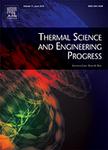版权所有:内蒙古大学图书馆 技术提供:维普资讯• 智图
内蒙古自治区呼和浩特市赛罕区大学西街235号 邮编: 010021

作者机构:NIT Durgapur Mech Engn Dept Durgapur 713209 India
出 版 物:《THERMAL SCIENCE AND ENGINEERING PROGRESS》 (Therm. Sci. Eng. Prog.)
年 卷 期:2019年第10卷
页 面:92-102页
核心收录:
基 金:SERB, DST, Govt. of India [SB/EMEQ-314/2013] Heat Power Laboratory (Mechanical Engineering Department-NIT Durgapur, India)
主 题:Solar air heater Twisted rib roughness Response surface methodology Particle swarm optimization Teaching learning based optimization
摘 要:The present investigation is undertaken with an objective to maximize thermo-hydraulic performance of solar air heater providing with twisted rib roughness. The optimization of various roughness parameters is done by implementing design of experiment (response surface methodology) and meta-heuristic (particle swarm optimization, teaching learning based optimization) approach for determining optimal thermo-hydraulic performance. The experimental work is conducted using Box Behnken design for 2nd order quadratic model. A mathematical model is developed for thermo-hydraulic performance in terms of roughness parameters e.g. pitch-height ratio (P/e), rib orientation (a), twist ratio (y/e) and Reynolds number (Re). The exorbitantly responsibility of rib roughness parameters on thermo-hydraulic performance is also discussed. The final optimum set of result for roughness parameters obtained by response surface methodology, particle swarm optimization, teaching learning based optimization technique are tested with experimental result to validate its robustness, flexibility and authenticity. The simulated optimized results obtained from teaching learning based optimization approaches exhibits quite satisfying with experimental data as far as competence, execution, reliability and global convergence.